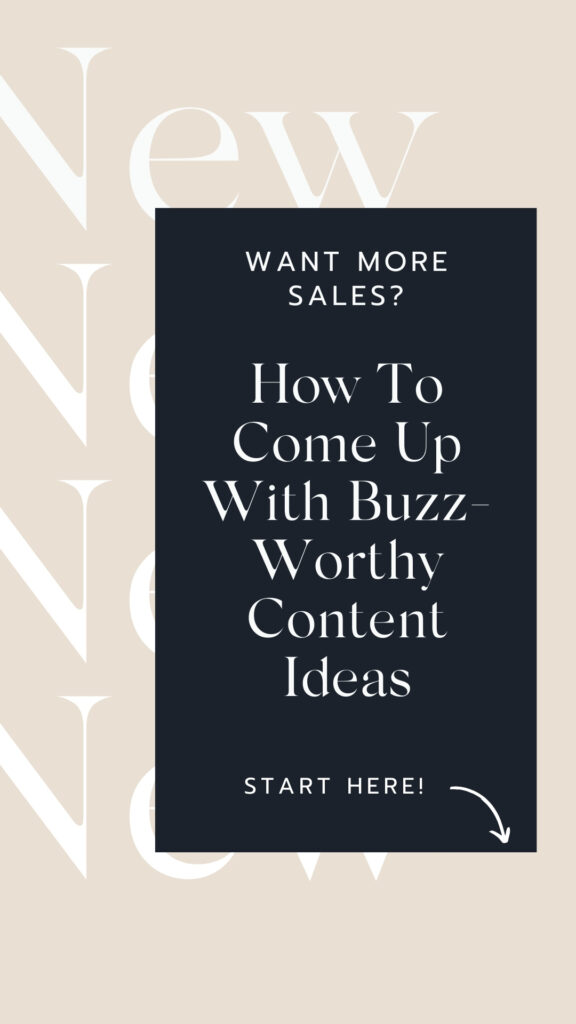How do we actually come up with ideas for our marketing content? That’s exactly what I want to know, and Nicole Czarnecki has answers. Nicole is absolutely brilliant at the creative side of marketing, especially the kind that’s very intentional and designed to drive real results. We’re talking all about buzz-worthy content ideas today!
Before we jump in though, sometimes, we think of marketers as either creative types or data-driven types. Personally, I lean more towards the blogging side because I don’t consider myself overly creative—I find the keyword first, and then the idea follows.
On the other hand, those who excel at social media content tend to lean more into the creative piece, though, of course, there are exceptions. But here’s the thing about Nicole: she’s incredibly creative, yet you’d never expect her to be so strategically focused. After many conversations with her, I’m consistently blown away by her brilliance, and I’m beyond excited to share our latest conversation with you on the podcast today. So, let’s get into it!
PSST: This is from my podcast episode with Nicole – if you want the full scoop (and trust me, we dropped some serious gems when it comes to finding content ideas), give it a listen!
Listen on Apple | Listen on Spotify
Table of Contents
Who is Nicole Czarnecki?
Nicole a seasoned social media and partnership marketing strategist, brings a decade of experience working with top consumer brands that resonate with women. She’s had the privilege of collaborating with big names like Jane Iredale, Dove, Amazon Prime, Country Crock, Panera Bread, Moroccanoil, Real Techniques, Elf Cosmetics, and Bustle Media Group.
In 2021, Nicole bid farewell to the hectic NYC agency life, where decisions about a single Instagram post involved over 20 people and endless delays. This led her to create Say Hey Social, a consultancy and fractional social media marketing firm designed to help early-stage indie brands and entrepreneurs build sustainable marketing systems and creative strategies that drive visibility and community.
Say Hey Social offers a range of strategic support tailored to a brand’s needs, including hourly consulting, full-service social media and partnerships management, influencer campaign execution, and a newly launched content calendar ideation subscription service for female founders. Nicole’s extensive network of creatives and social influencers empowers her to elevate content and community building for brands of all sizes.

How can small businesses balance the kind of content ideas we create?
My recommendation is always to content batch, and plan your content ahead of time. Obviously talking about the evergreen things that are important to your business, whether it’s educational, inspirational, or truly sales forward content so that when that trend crosses your feed that you are personally excited about as a business owner, you have the time to tap into it and create that content because you’ve already got much of your feed content shared that week.
So for me, trends are more almost like a 2.0 social tactic for businesses who are able to keep up with the social machine. I think it’s more important that you’re sharing brand messaging and content that you feel like is going to relate really, really specifically to your audience than it is to just get tied into meme culture.
So for me, if you have, again, let’s say your goal is to post 20 times in a month, four times a week, if you could schedule three posts a week and sit down for 30 minutes and identify what’s going on in the wild, and think about how it relates to you. For me with trends too, it really has to make sense to you.
Nothing should ever be forced. The last thing, and I think performance really shows this, but when people just again slap their brand or a quote on a meme, it doesn’t perform well unless there’s real intent and passion and thought, which has to happen naturally. So for me, it’s about being really planned so that you have time to even think about what’s happening in trend to play into it versus not.
Can you share two to three content formats from your playbook that most of us aren’t using but should consider?
It’s crucial to have a list of go-to content formats when you start to think about content ideas. When you have an idea for a post, it’s much easier to refer to your list and see how it can come to life rather than starting from scratch.
The first format that comes to mind is user-generated content (UGC). Many people think of UGC as just one thing, but it can be an umbrella for different types like influencer-generated content (IGC) or customer-generated content (CGC). Old-school marketing teaches us about paid, owned, and earned media, and earned media, in my opinion, is still king. Whether it’s a review, a reel from a customer, a photo, or an email testimonial turned into content, the voice of others is still vital in marketing your brand.
Another format I recommend is “Day in the Life” content. Data shows that consumers, especially Gen Z, are more interested in following founders than brands—they want to see behind the scenes. To execute this, film 10-15 clips of yourself, each 2-3 seconds long, piece them together, add a voiceover, and use trending audio with a compelling cover. This format allows you to inject different parts of yourself into the content, which is key—you can’t just sell with every post.
Finally, the lowest-hanging fruit is the carousel format. Whether it’s a carousel dump or an educational series, carousels require engagement, as users must swipe and interact with your content. This format offers immense value, often even greater than video content. Plus, Instagram’s algorithm currently favors carousels, so it’s wise to use the features the platform is pushing.
Can you share a few examples of big brands leveraging collaboration in unexpected or particularly effective ways when it comes to content ideas?
Collab posts, introduced last year, have significantly impacted small businesses, especially on Instagram. The goal of any content, particularly on Instagram, is to reach not only your existing audience but also a new one.
The collab tool enables this by allowing brands to partner with like-minded companies that don’t yet have audience overlap, expanding reach effectively. This resurgence in brand-to-brand collaborations is similar to how influencer marketing has always worked, with creative alignment being key. The collaboration should make sense creatively, whether through a shared campaign, values, or mission.
A great example is a recent campaign by Beis, Shea Mitchell’s travel luggage brand. They partnered with TikTok marketing strategist Girl Boss Town, who pitched them an idea via TikTok. Bayes then collaborated with popular Instagram dads to rebrand the “airport dad” image with an innovative, stylish photoshoot. This campaign is a prime example of brands leveraging independent strategists to execute creative collaborations. Here’s the campaign Nicole talks about in the episode!
Another notable example is Goldfish’s collaboration with castmates from the popular millennial show Summer House. After a public breakup on the show, Cheez-It cleverly partnered with the other half of that breakup alongside Goldfish. This playful approach highlights how marketers are pushing creative boundaries, with collaborations becoming more dynamic and cross-industry than ever before.
Looking ahead, I believe the future of marketing lies in these bespoke, custom campaigns driven not just by internal teams but by independent strategists and influencers who bring fresh, creative ideas to the table.

What do you think is a realistic amount of time to spend on social media and how do we make the most of this time?
When organizing your time on social media, it’s important to break it down and identify what tasks you should handle and which ones you might want to outsource. Start by recognizing the tasks you dislike or aren’t good at—those are prime candidates for outsourcing. For example, if you’re great at video editing but struggle with copywriting, bringing in a copywriter can free up significant time and make your efforts more efficient.
I recommend spending one hour a month planning your upcoming content. During this time, identify key dates and milestones for your business or in culture that you need to highlight, and then spend an additional 30 minutes brainstorming 10-20 evergreen post ideas. These ideas should align with the themes of selling, entertaining, educating, and inspiring your audience. This planning session will give you a clear roadmap for the month.
On a weekly basis, try to dedicate two hours to content creation. I suggest taking Fridays off from posting and using that time to create content—whether it’s shooting videos, curating photos, or editing and scheduling your posts for the week. This routine will save you time in the long run, as having content pre-scheduled in platforms like Later or Plan ensures you’re not scrambling day-to-day.
For daily social media work, aim to spend 15 minutes a day on active tasks like posting, engaging with your audience, and responding to comments or DMs. This short daily check-in is enough to stay on top of trends and keep your social presence active. If you naturally spend more time on social media, consider that additional scrolling as research and trend tracking.
If you find idea generation challenging or find it time-consuming to come up with content ideas, that’s when you might want to join my membership, where I can help you build out your content calendar and generate ideas. Overall, expect to spend about 5 to 10 hours a month on social media, depending on your content strategy. Track your time, see what tasks take the most effort, and consider outsourcing those that don’t fit your strengths or schedule.
Want more of Nicole’s insights? This is just a glimpse – for the full spectrum of marketing wisdom, check out the entire episode!
LINKS MENTIONED:
- Learn more about working with Nicole
- Follow Nicole on Instagram
- Follow Nicole on LinkedIn
- Learn more about working with our marketing agency here
- Follow me on Instagram